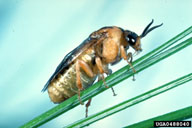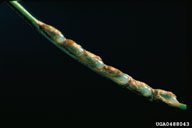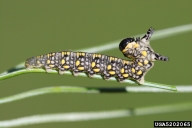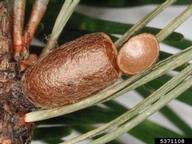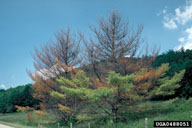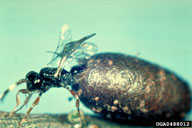Introduced pine sawfly
Diprion similis (Hartig) (Hymenoptera: Diprionidae)
Orientation to pest
Introduced pine sawfly, Diprion similis (Hartig), is an invasive species in North America, of Eurasia origin that defoliates eastern white pine (Pinus strobus L.) and some other pines. It occurs widely in eastern Canada and the United States. Winter is spent in the prepupal stage in a cocoon on the tree or in the duff. Insects pupate in early spring and adults emerge by May to mid-June. Females lay eggs in rows of up to 10 in slits cut in needles of hosts. Young larvae feed in groups, but older larvae feed alone. Larvae of the first generation feed on old needles only, but larvae of the second generation eat both old and new needles. Normally there are two generations per year, but in favorable areas, there may be a partial third generation. Infested trees may be defoliated and trees may be killed.
Hosts commonly attacked
This species feeds on pines, especially eastern white pine (P. strobus). Scotch (Pinus sylvestris L.), red (Pinus resinosa Sol. ex Aiton), jack (Pinus banksiana Lamb.), and mugo (Pinus mugo Turra) pines are also attacked.
Distribution
In the United States, this sawfly is found from Maine west to Minnesota and south to North Carolina, Tennessee, and Virginia. In Canada, it is present in Newfoundland, Nova Scotia, New Brunswick, Prince Edward Island, Quebec, Ontario, and Manitoba.
Images of introduced pine sawfly
| Figure 1. Adult of introduced pine sawfly, Diprion simili | Figure 2. Eggs of introduced pine sawfly inserted into a pine needle | Figure 3. Larvae of introduced pine sawfly |
| Figure 4. Cocoon (emerged) of introduced pine sawfly | Figure 5. Defoliation of eastern white pines due to introduced pine sawfly larvae | Figure 6. Emergence of the ichneumonid parasitoid Exenterus amictorius (Panzer) from a cocoon of introduced pine sawfly |
Important biological control agents related to this pest species
In Europe, many species of parasitoids have been reared from D. similis, including most commonly Aptesis subguttatus (Grav.), Aptesis basizonia (Grav.), Exenterus amictorius (Panzer), Exenterus adspersus Hartig., Palexorista inconspicua (Meigen), Hypsantyx impressus (Grav.), and Monodontomerus dentipes (Dalman). Palexorista inconspicua is believed by some to be the most important tachinid parasitoid of D. similis in Europe. In North America, D. similis is attacked by several European parasitoids that were introduced against other closely related invasive sawflies. In Connecticut, nearly 50% of D. similis larvae were parasitized by a complex of eight parasitoid species, especially M. dentipes, which was also one of the most important parasitoids in Pennsylvania and New Jersey. In Minnesota, the most common parasitoids were E. amictorius, M. dentipes, and Delomerista japonica Cushman. Diprion similis did not invade the southern United States until the 1970s, and in that region, few parasitoid species were found attacking the pest. Monodontomerus dentipes was introduced to the region, where it became abundant and was credited with controlling the pest in North Carolina.
Web links for information on introduced pine sawfly
- Fact Sheet | Natural Resources Canada
- Fact Sheet on ForestPests.org | Vermont Division of Forestry
- Forest Insect & Disease Leaflet 99 | USDA Forest Service
Articles
- Monroe, H. A. U. 1935. Observations on the habits of an introduced pine sawfly Diprion simile Htg. The Canadian Entomologist 67: 137-140.
- Tsao, C. H. and A. C. Hodson. 1956. The effect of different host species on the oviposition and survival of the introduced pine sawfly. Journal of Economic Entomology 49: 400-401.
- Coppel, H. C., J. W. Mertins, and J. W. E. Harris. 1974. The introduced pine sawfly, Diprion similis (Hartig) (Hymenoptera: Diprionidae) A review with emphasis on studies in Wisconsin. University of Wisconsin-Madison Research Bulletin R 2393, 74 pp.
- Drooz, A. T.; J. H. Ghent, and C. M. Huber, C. M. 1985. Insect parasites associated with the introduced pine sawfly, Diprion similis (Hartig) (Hymenoptera: Diprionidae), in North Carolina. Environmental Entomology 14: 401-403.
